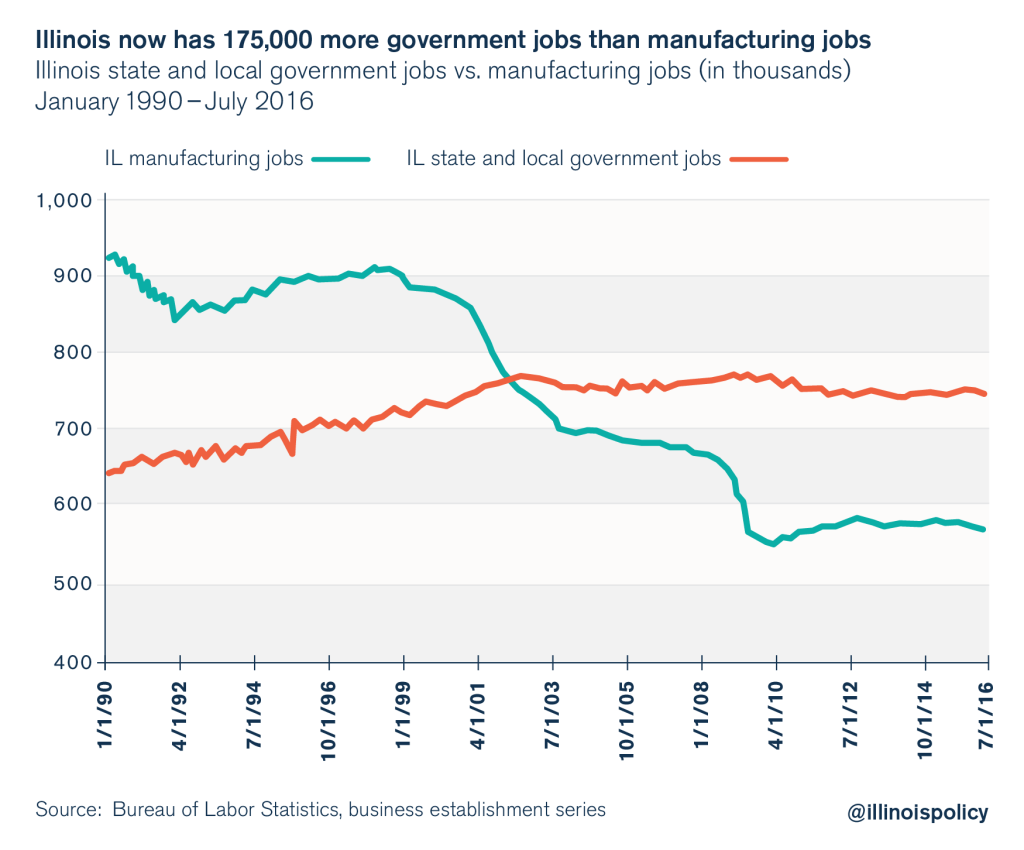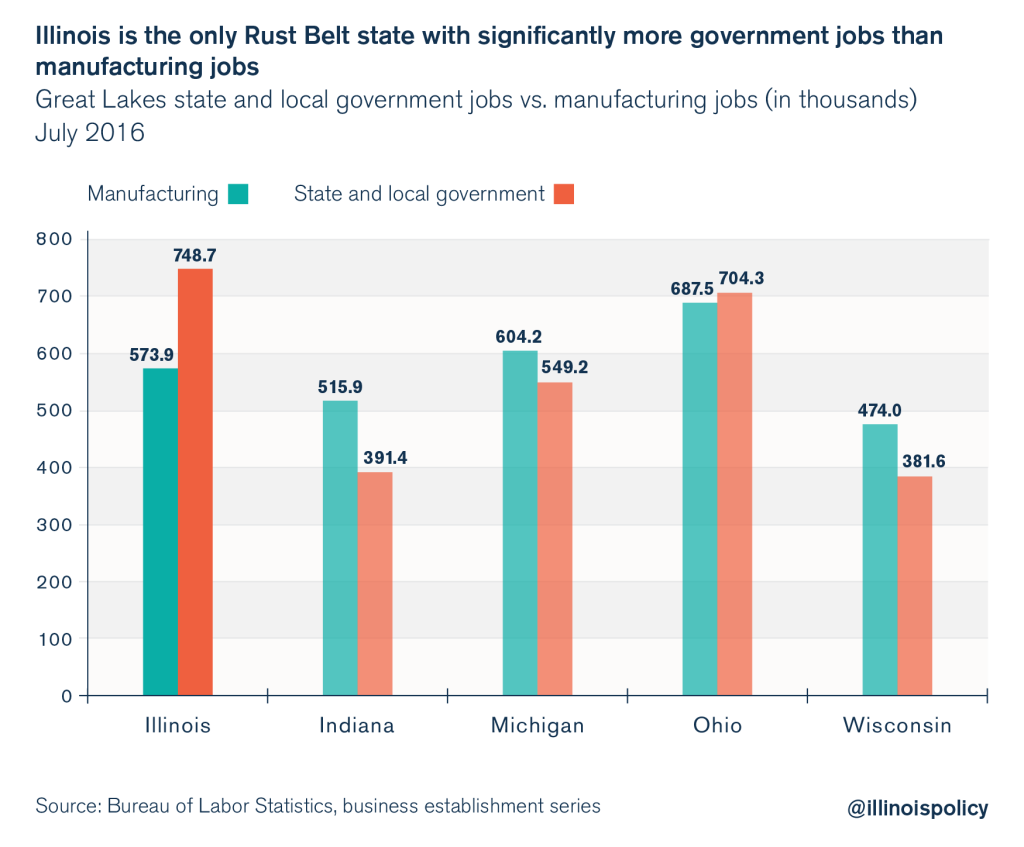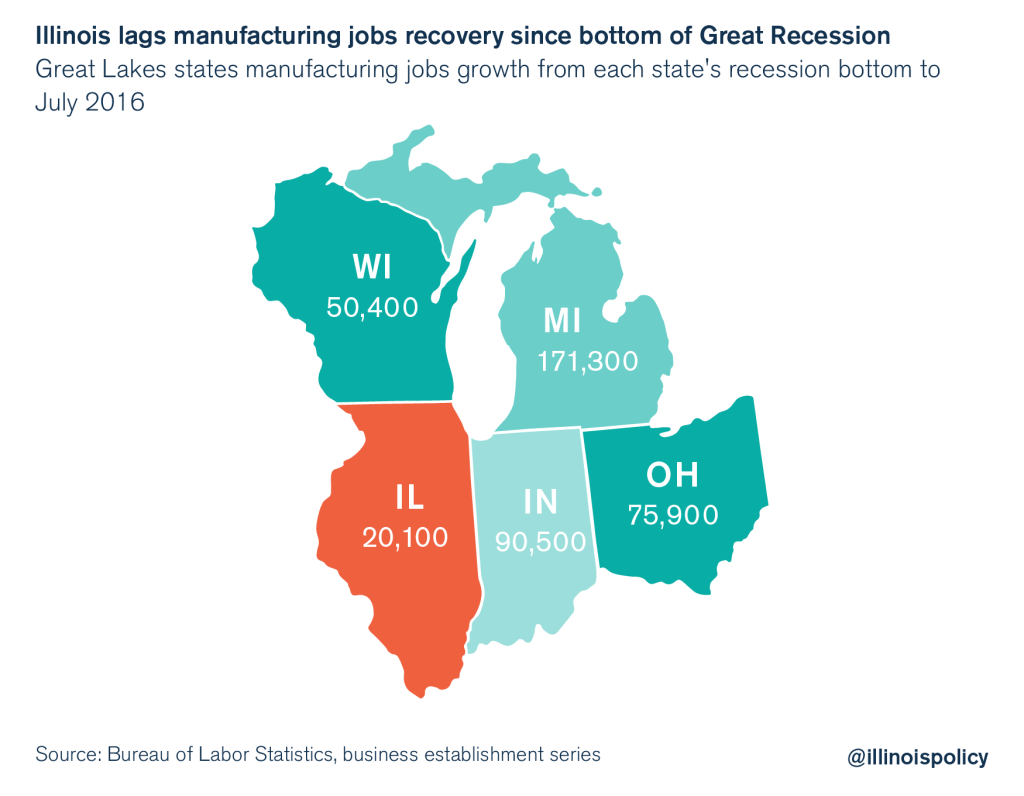Government jobs surpass manufacturing jobs by 175,000 in Illinois
Illinois stands out in the industrial Midwest for its skewed government-to-manufacturing-jobs ratio.
Illinois and the Great Lakes states are America’s traditional manufacturing powerhouses. When the Industrial Revolution transformed Midwestern cities into prosperous production centers, the manufacturing sector drove up wages and employment for a large swath of Illinois’ middle class. But now government jobs are far more common than manufacturing jobs in Illinois.
In March 2002, Illinois state and local government jobs surpassed manufacturing jobs for the first time in Illinois’ recorded history. Since then, the ratio of government jobs to manufacturing jobs has moved in favor of government work, as Illinois manufacturing jobs have plummeted, while government jobs have remained steady. There are now 175,000 more jobs in state and local government in Illinois than there are in manufacturing, a striking change in a state in which production jobs once formed the backbone of middle-class opportunity.

Illinois’ weak economic recovery has led to the smallest manufacturing-to-government-jobs ratio in the industrial Midwest
Of the five largest manufacturing states in the Midwest, Illinois is the only one with significantly more government workers than manufacturing workers. In Indiana, there are 125,000 more manufacturing jobs than government jobs; in Wisconsin, there are 92,000 more manufacturing jobs than government jobs; in Michigan there are 55,000 more manufacturing jobs than government jobs; and in Ohio, government jobs slightly outnumber manufacturing jobs by 17,000.

One factor that has driven the disparity between Illinois and other manufacturing states in the Midwest is Illinois’ poor recovery from the Great Recession. Illinois lost more than 120,000 manufacturing jobs during the economic downturn of the Great Recession. And Illinois has regained only 20,000 manufacturing jobs since hitting bottom in January 2010. Since their respective recession bottoms, the other Midwestern manufacturing states have added tens of thousands more manufacturing jobs than has Illinois, helping to drive all of their unemployment rates at least one point lower than Illinois’.
 Reforms to bring back Illinois’ manufacturing sector
Reforms to bring back Illinois’ manufacturing sector
Illinois needs spending, tax and regulatory reform to make the state more attractive for manufacturing investments and the jobs that come with them.
Spending reform should include changes to the state’s pension systems, including an amendment to the Illinois Constitution’s pension-protection clause. Collective bargaining with government unions should be optional rather than mandatory, so local governments can better manage their costs and employees. And Illinois local governments should be consolidated as necessary to eliminate duplicative services. All of these reforms would help drive down the cost of government – and the property taxes needed to fund it.
Tax reforms should focus on lowering property taxes and making the tax code more pro-growth. Manufacturing firms will be much likelier to invest in Illinois if they think they can get a solid return on their investment, after factoring in the cost of taxes and regulations. The estate and franchise taxes should be repealed, because they directly tax manufacturing capital in Illinois and create an incentive for companies to locate their machinery outside the state. Furthermore, the sales tax can be expanded to services in order to lower income taxes and exempt business inputs from sales taxation.
Finally, policymakers should prioritize regulatory reform for the state’s workers’ compensation system, which affects manufacturers more than employers in many other sectors. Illinois’ workers’ compensation system has high medical, wage-replacement and indemnity costs, along with financial incentives for physicians to dispense potentially harmful drugs and for workers to stay out of work.
Reinvigorating Illinois’ manufacturing sector will take time and significant policy reforms to restore the state’s competitiveness and fiscal viability. It is urgent that lawmakers come together on these points to help Illinois’ production workers get back on the job.
